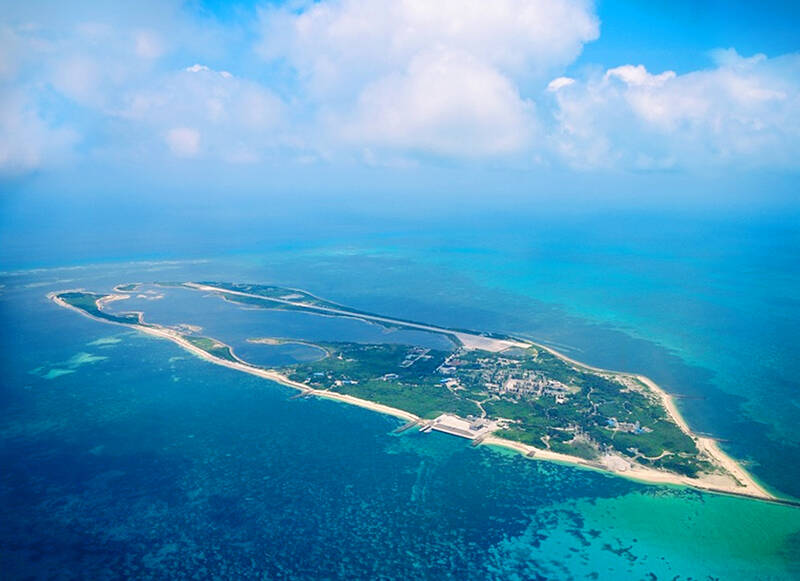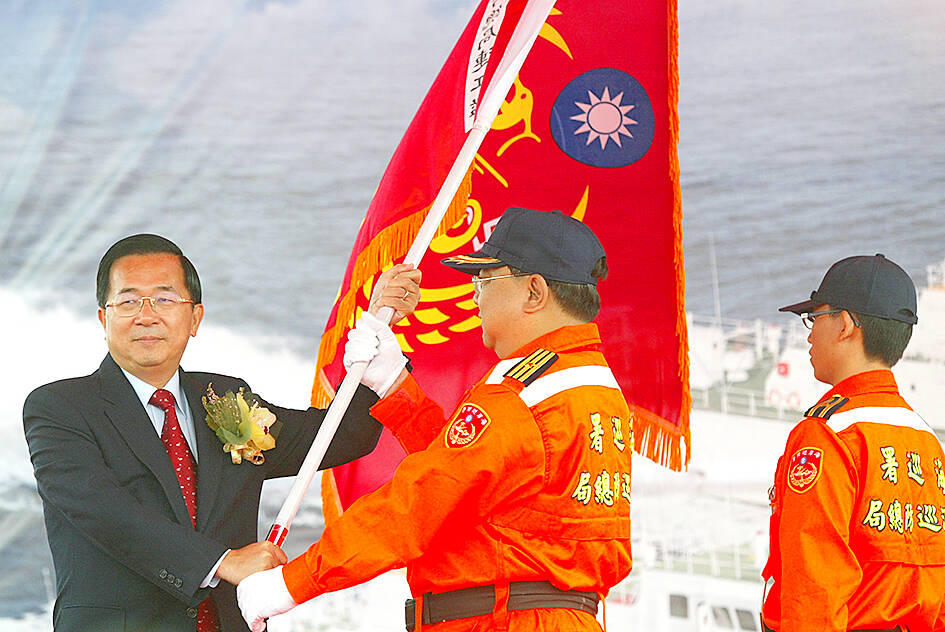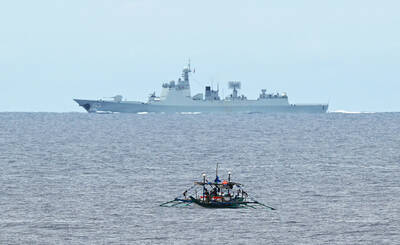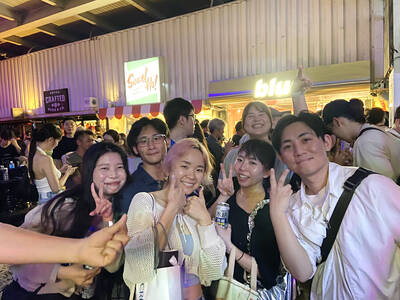Pratas Island, or Dongsha (東沙群島) had lain off the southern coast of China for thousands of years with no one claiming it until 1908, when a Japanese merchant set up a facility there to harvest guano. The Americans, then overlords of the Philippines, disturbed to learn of Japanese expansion so close to their colony, alerted the Manchu (Qing) government.
That same year the British government asked the Manchus who owned the island, which prompted the Manchu government to make a claim, according to South China Sea expert Bill Hayton. In 1909 the government of Guangdong finally got around to sending a ship to investigate the matter and develop a claim to the island. Thus Pratas Island entered the Great Game.
A century later, in 2007, then-president Chen Shui-bian (陳水扁) established a national park on the island, the Dongsha Atoll National Park, in order to strengthen ROC sovereignty over the island. In February 2008 Chen also visited ROC holdings in the Spratlys (Nansha Islands, 南沙群島). He was the last president from the Democratic Progressive Party (DPP) to do so. Successive DPP administrations have come and gone, but consistent DPP policy has been to keep a low profile on the ROC’s claims in the South China Sea.

Photo courtesy of Chen Ching-neng
Hence, it came as a surprise last week when, in the Jamestown China Brief, Andrew Erickson, Jason Wang, Pei-Jhen Wu and Marvin Bernado broke the news that the PRC was placing oil platforms in the exclusive economic zone (EEZ) the government claims around Pratas Island. “Rigging the Game: PRC Oil Structures Encroach on Taiwan’s Pratas Island,” the piece was titled, though Pratas isn’t claimed by Taiwan, but by the ROC.
The piece observed that the oil structures, designed to advance Beijing’s territorial claims, “could facilitate a full range of coercion, blockade, bombardment and/or invasion scenarios against Pratas or Taiwan” if kitted with military sensors and other equipment. It also implicitly criticized the government: “By operating rigs in a neighbor’s claimed EEZ, Beijing already has succeeded with Taiwan where it failed repeatedly with Vietnam.”
LAZY COMPARISON

Photo: Chang Chung-yi, Taipei Times
The writers attributed Vietnam’s success in ridding itself of oil platforms to persistent protest. They also instanced Japan’s sustained opposition to PRC buoys in its waters that led to their removal. Given these examples, they contend that Taipei’s failures to protest normalizes the PRC’s “gray zone” tactics and encourages further such behavior.
The platforms had been encroaching on the Pratas Island EEZ since at least May of 2020, something the government surely knew. Moreover, in a now-forgotten incident that may have been connected to the deployment of the platforms, in the fall of 2020 the Hong Kong civil air control told a resupply mission to Pratas island not to enter the area because of “dangerous activities.”
Apparently it did not occur to any of the authors to ask why in five years there had been no public protests by the government, and why it had not made the existence of the platforms public knowledge. The authors observe that “Taiwan’s Coast Guard routinely repels China Coast Guard vessels from Pratas restricted waters and expels or seizes intruding fishing boats,” lauding that as a successful example of pushback. But while private fishing boats can be expelled without international or domestic consequences, the drilling platforms are controlled by the PRC government.
Vietnam, whose response Erickson et al laud, is a fully sovereign state which has defeated the PRC in war within living memory. By contrast, Taiwan’s sovereignty is impaired, intermingled with the occupying and colonial ROC. Since the ROC claims the islands, and in the eyes of many foreigners, also claims to be China, a demand for foreign intervention in the event of a PRC assault on the islands would look to many outsiders like they were being asked to defend China from China.
Taipei knows full well that protests would be ignored, as they are over the numerous actions from the PRC’s air and sea space incursions to its attacks on Taiwan’s diplomatic space to trivialities like suppressing Taiwan movie exhibitions or attempts by its airlines to obtain gate privileges at international airports. The PRC grudgingly respects Vietnam, but it hates and detests Taiwan and will never listen to protests.
Direct military pushback by Taipei could trigger a war whose loss would destroy Taiwan, never mind the damage to the global and regional economy. No Vietnamese confrontation with PRC expansion could trigger a similarly existential crisis. Vietnam can push back more directly because it is safe to do so.
DOMESTIC HEADACHES
Further, the ROC’s island claims cause domestic headaches for the DPP. The pro-China Chinese Nationalist Party (KMT) uses the claims to criticize the DPP at home for being insufficiently nationalist, while exploiting them to irritate relations with Taiwan’s neighbors, who also claim the islands. Good management of these possibilities requires keeping a low profile in the South China Sea.
Surely the journalists and writers who broke this story on Sept. 2 understood what they were doing. Does this information truly need to be public? The Taiwan military is well aware of the existence and military implications of the platforms. Public knowledge changes nothing in that regard, while simply causing unnecessary domestic headaches for an administration friendly to the US.
Moreover, local agency jurisdiction over the response to the platforms in Taiwan is unclear. Recall that KMT legislator Chen Yeong-kang (陳永康) has proposed transferring authority over restricted and prohibited waters near the outlying islands from the military to the Coast Guard, which is under the authority of the Ocean Affairs Council (OAC). Critics saw the move as intended to turn control over the waters to local authorities aligned with the PRC. News like this could give this idea fresh impetus.
As of this writing, the William Lai (賴清德) Administration has handled the story by making boilerplate noises. The presidential office told the PRC that “as a member of the regional bloc, China must explain its action to fellow country members, and must immediately terminate drilling activities and other illegal activity within Taiwan’s and other countries’ EEZs,” it said. A few local politicians made remarks, and the issue appears to have faded.
The South China Sea claims throw into sharp relief the distinction between the ROC and Taiwan. The ROC administrates Taiwan and its associated islands, but has no sovereignty over Taiwan under international law. The ROC’s island claims in the South China Sea have historically never been considered part of Taiwan. Despite this, as Erickson et al did above, writers constantly conflate the two, referring to islands and sea zones as “Taiwan’s,” “Taiwan-controlled” or “Taiwan-held,” missing the opportunity to educate readers about the complicated sovereignty issues. Though the term “ROC” has vanished in the media, it is the reason Taiwan is linked to the islands, the reason good Taiwanese boys may have to die to defend the ROC’s claims.
Taipei still has time to hand these islands over to other claimants, gain benefits in return and remove the threat to Taiwan.
Notes from Central Taiwan is a column written by long-term resident Michael Turton, who provides incisive commentary informed by three decades of living in and writing about his adoptive country. The views expressed here are his own.

Cheng Ching-hsiang (鄭青祥) turned a small triangle of concrete jammed between two old shops into a cool little bar called 9dimension. In front of the shop, a steampunk-like structure was welded by himself to serve as a booth where he prepares cocktails. “Yancheng used to be just old people,” he says, “but now young people are coming and creating the New Yancheng.” Around the corner, Yu Hsiu-jao (饒毓琇), opened Tiny Cafe. True to its name, it is the size of a cupboard and serves cold-brewed coffee. “Small shops are so special and have personality,” she says, “people come to Yancheng to find such treasures.” She

Late last month Philippines Foreign Affairs Secretary Theresa Lazaro told the Philippine Senate that the nation has sufficient funds to evacuate the nearly 170,000 Filipino residents in Taiwan, 84 percent of whom are migrant workers, in the event of war. Agencies have been exploring evacuation scenarios since early this year, she said. She also observed that since the Philippines has only limited ships, the government is consulting security agencies for alternatives. Filipinos are a distant third in overall migrant worker population. Indonesia has over 248,000 workers, followed by roughly 240,000 Vietnamese. It should be noted that there are another 170,000

Hannah Liao (廖宸萱) recalls the harassment she experienced on dating apps, an experience that left her frightened and disgusted. “I’ve tried some voice-based dating apps,” the 30-year-old says. “Right away, some guys would say things like, ‘Wanna talk dirty?’ or ‘Wanna suck my d**k?’” she says. Liao’s story is not unique. Ministry of Health and Welfare statistics show a more than 50 percent rise in sexual assault cases related to online encounters over the past five years. In 2023 alone, women comprised 7,698 of the 9,413 reported victims. Faced with a dating landscape that can feel more predatory than promising, many in

Former Chinese Nationalist Party (KMT) chairwoman Hung Hsiu-chu’s (洪秀柱) attendance at the Chinese Communist Party’s (CPP) “Chinese People’s War of Resistance Against Japanese Aggression and the World Anti-Fascist War” parade in Beijing is infuriating, embarrassing and insulting to nearly everyone in Taiwan, and Taiwan’s friends and allies. She is also ripping off bandages and pouring salt into old wounds. In the process she managed to tie both the KMT and the Democratic Progressive Party (DPP) into uncomfortable knots. The KMT continues to honor their heroic fighters, who defended China against the invading Japanese Empire, which inflicted unimaginable horrors on the